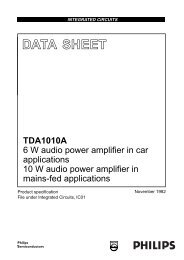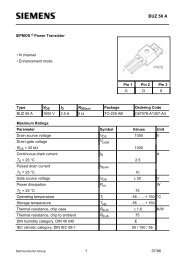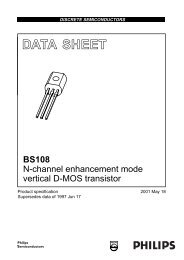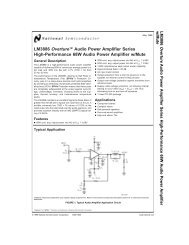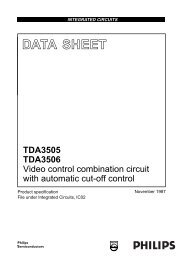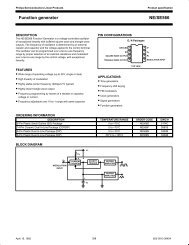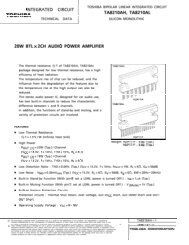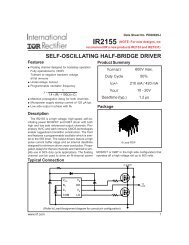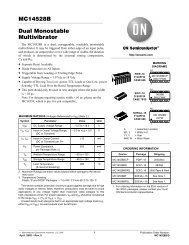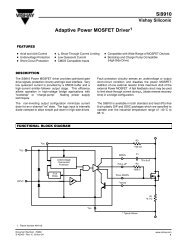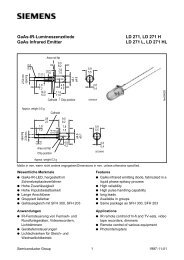TDA3566A PAL/NTSC decoder
TDA3566A PAL/NTSC decoder
TDA3566A PAL/NTSC decoder
Create successful ePaper yourself
Turn your PDF publications into a flip-book with our unique Google optimized e-Paper software.
Philips SemiconductorsProduct specification<strong>PAL</strong>/<strong>NTSC</strong> <strong>decoder</strong><strong>TDA3566A</strong>FEATURES• A black-current stabilizer whichcontrols the black-currents of thethree electron-guns to a level lowenough to omit the black-leveladjustment• Contrast control of inserted RGBsignals• No black-level disturbance whennon-synchronized external RGBsignals are available on the inputs• <strong>NTSC</strong> capability with hue control.APPLICATIONS• Teletext/broadcast antiope• Channel number display.GENERAL DESCRIPTIONThe <strong>TDA3566A</strong> is a <strong>decoder</strong> for the<strong>PAL</strong> and/or <strong>NTSC</strong> colour televisionstandards. It combines all functionsrequired for the identification anddemodulation of <strong>PAL</strong>/<strong>NTSC</strong> signals.Furthermore it contains a luminanceamplifier, an RGB-matrix andamplifier. These amplifiers supplyoutput signals up to 4 V peak-to-peak(picture information) enabling directdrive of the discrete output stages.The circuit also contains separateinputs for data insertion, analog anddigital, which can be used for textdisplay systems.QUICK REFERENCE DATAAll voltages referenced to ground.SYMBOL PARAMETER MIN. TYP. MAX. UNITSupplyV P supply voltage (pin 1) − 12 − VI P supply current (pin 1) − 90 − mALuminance amplifier (pin 8)V 8(p-p) input voltage (peak-to-peak value) − 450 − mVCON contrast control − 16.5 − dBChrominance amplifier (pin 4)V 4(p-p) input voltage (peak-to-peak value) 40 − 1100 mVSAT saturation control − 50 − dBRGB matrix and amplifiersV 13, 15, 17(p-p)Data insertionoutput voltage at nominal luminance and contrast(peak-to-peak value)− 3.8 − VV 12, 14, 16(p-p) input signals (peak-to-peak value) − 1 − VData blanking (pin 9)V 9 input voltage for data insertion 0.9 − − VSandcastle input (pin 7)V 7 blanking input voltage − 1.5 − VV 7 burst gating and clamping input voltage − 7 − VORDERING INFORMATIONEXTENDED TYPENUMBERPACKAGEPINS PIN POSITION MATERIAL CODE<strong>TDA3566A</strong> 28 DIL plastic SOT117February 1994 2
Philips SemiconductorsProduct specification<strong>PAL</strong>/<strong>NTSC</strong> <strong>decoder</strong><strong>TDA3566A</strong>sandcastlepulseDELAY LINE12 VdatablankingBLUEinsertioncontrastbrightnessluminanceinput8AMPLIFIERBLACK LEVELINSERTION(4L)28 723 22 27 1 9 16 611SANDCASTLE DETECTORBMATRIXDATASWITCHSTAGECONTRAST BRIGHTNESSAMPLIFIERBUFFER&BLANKINGBLACK LEVELCLAMPINGBLACK LEVELREFERENCEH V HBLANKINGBURSTGATINGLIN/LOGCONVERTORBRIGHTNESSBLACKLEVELCLAMPINGblanking(BL3)saturation5LIN/LOGCONVERTER2I L LOGIC &BUFFER STAGES(B Y)DEMODULATORisolationpulse(4L)clamppulse(L3)chrominanceinput4CONTROLLED CHROMINANCEAMPLIFIERGATEDSATURATIONCONTROLGATED CHROMINANCEAMPLIFIERBUFFER(G Y)MATRIX<strong>TDA3566A</strong>LEAKAGECURRENTCLAMPING(L0)DELAYEDSWITCH-ONclamppulse(L2)3PEAKDETECTORKILLERDETECTORIDENTIFICATION<strong>PAL</strong>FLIP-FLOP(R Y)DEMODULATOR2CLAMPEDDETECTORAMPLIFIERH/2 DETECTOR<strong>PAL</strong>SWITCH290 o SHIFTblanking(BL1)clamppulse(L1)<strong>PAL</strong>/<strong>NTSC</strong>MODESWITCH(R Y) (B Y)REFERENCESWITCHPHASEGATEDBURSTDETECTOR8.8 MHzOSCILLATOR25 24 26blanking(BL1)clamppulse(L1)8.8 MHz crystal (<strong>PAL</strong>)12 V7.16 MHz crystal (<strong>PAL</strong>/<strong>NTSC</strong>)For explanation of pulse mnemonics see Fig. 7.Fig.1 Block diagram.17201918141521121310MGA819BLUEoutputblackcurrentinformation(M)GREENinsertionGREENoutputREDinsertionREDoutputFebruary 1994 3
Philips SemiconductorsProduct specification<strong>PAL</strong>/<strong>NTSC</strong> <strong>decoder</strong><strong>TDA3566A</strong>PINNINGSYMBOL PIN DESCRIPTIONV P 1 supply voltageIDDET 2 identification detection levelACCDET 3 Automatic Chrominance Control detection levelCHR IN 4 chrominance control inputSAT 5 saturation control inputCON 6 contrast control inputSC 7 sandcastle inputLUM 8 luminance control inputDBL 9 data blanking inputBCL R 10 black clamp level for RED outputBRI 11 brightness inputR IN 12 RED inputR OUT 13 RED outputG IN 14 GREEN inputG OUT 15 GREEN outputB IN 16 BLUE inputB OUT 17 BLUE outputBLA 18 black current inputBCL 19 black clamp level; referenced to black levelBCL B 20 black clamp level for BLUE outputBCL G 21 black clamp level for GREEN outputB−Y 22 demodulator input (BLUE)R−Y 23 demodulator input (RED)RCEXT 24 gated burst detector load networkRCEXT 25 gated burst detector load networkOSC 26 oscillator frequency inputGND 27 groundCHR OUT 28 chrominance signal outputV PIDDETACCDETCHRINSATCONSC123456728272625242322<strong>TDA3566A</strong>LUMDBLBCLRBRIR INR OUTG IN89101112131421201918171615MLA407Fig.2 Pin configuration.CHR OUTGNDOSCRCEXTRCEXTR YB YBCLGBCLBBCLBLAB OUTB ING OUTFebruary 1994 4
Philips SemiconductorsProduct specification<strong>PAL</strong>/<strong>NTSC</strong> <strong>decoder</strong><strong>TDA3566A</strong>FUNCTIONAL DESCRIPTIONThe <strong>TDA3566A</strong> is a furtherdevelopment of the TDA3562A. It hasthe same pinning and nearly thesame application. The differencesbetween the TDA3562A and the<strong>TDA3566A</strong> are as follows:• The <strong>NTSC</strong>-application has largelybeen simplified. In the event of<strong>NTSC</strong> the chrominance signal isnow internally coupled to thedemodulators, automaticchrominance control (ACC) andphase detectors. The chrominanceoutput signal (pin 28) is thussuppressed. It follows that theexternal switches and filters whichare required for the TDA3562A arenot required for the <strong>TDA3566A</strong>.There is no difference between theamplitudes of the colour outputsignals in the <strong>PAL</strong> or <strong>NTSC</strong> mode.• The clamp capacitor at pins 10, 20and 21 in the black-levelstabilization loop can be reduced to100 nF provided the stability of theloop is maintained. Loop stabilitydepends on complete application.The clamp capacitors receive apre-bias voltage to avoid colouredbackground during switch-on.• The crystal oscillator circuit hasbeen changed to prevent parasiticoscillations on the third overtone ofthe crystal. Consequently theoptimum tuning capacitance mustbe reduced to 10 pF.• The hue control has been improved(linear).Luminance amplifierThe luminance amplifier is voltagedriven and requires an input signal of450 mV peak-to-peak (positivevideo). The luminance delay line mustbe connected between the IFamplifier and the <strong>decoder</strong>.The input signal is AC coupled to theinput (pin 8). After amplification, theblack level at the output of thepreamplifier is clamped to a fixed DClevel by the black level clampingcircuit. During three line periods aftervertical blanking, the luminancesignal is blanked out and the blacklevel reference voltage is inserted bya switching circuit.This black level reference voltage iscontrolled via pin11 (brightness). Atthe same time the RGB signals areclamped. Noise and residual signalshave no influence during clampingthus simple internal clamping circuitryis used.Chrominance amplifiersThe chrominance amplifier has anasymmetrical input. The input signalmust be AC coupled (pin 4) and havea minimum amplitude of40 mV peak-to-peak.The gain control stage has a controlrange in excess of 30 dB, themaximum input signal must notexceed 1.1 V peak-to-peak,otherwise clipping of the input signalwill occur.From the gain control stage thechrominance signal is fed to thesaturation control stage. Saturation islinearly controlled via pin 5. Thecontrol voltage range is 2 to 4 V, theinput impedance is high and thesaturation control range is in excessof 50 dB.The burst signal is not affected bysaturation control. The signal is thenfed to a gated amplifier which has a12 dB higher gain during thechrominance signal. As a result thesignal at the output (pin 28) has aburst-to-chrominance ratio which is6 dB lower than that of the inputsignal when the saturation control isset at −6 dB.The chrominance output signal is fedto the delay line and, after matrixing,is applied to the demodulator inputpins (pins 22 and 23). These signalsare fed to the burst phase detector. Inthe event of <strong>NTSC</strong> the chrominancesignal is internally coupled to thedemodulators, ACC and phasedetectors.Oscillator and identification circuitThe burst phase detector is gatedwith the narrow part of the sandcastlepulse (pin 7). In the detector the(R−Y) and (B−Y) signals are added toprovide the composite burst signalagain.This composite signal is comparedwith the oscillator signaldivided-by-2 (R−Y) reference signal.The control voltage is available atpins 24 and 25, and is also applied tothe 8.8 MHz oscillator. The 4.4 MHzsignal is obtained via the divide-by-2circuit, which generates both the(B−Y) and (R−Y) reference signalsand provides a 90° phase shiftbetween them.The flip-flop is driven by pulsesobtained from the sandcastledetector. For the identification of thephase at <strong>PAL</strong> mode, the (R−Y)reference signal coming from the <strong>PAL</strong>switch, is compared to the verticalsignal (R−Y) of the <strong>PAL</strong> delay line.This is carried out in the H/2 detector,which is gated during burst.When the phase is incorrect, theflip-flop gets a reset from theidentification circuit. When the phaseis correct, the output voltage of theH/2 detector is directly related to theburst amplitude so that this voltagecan be used for the ACC.To avoid 'blooming-up' of the pictureunder weak input signal conditionsthe ACC voltage is generated by peakdetection of the H/2 detector outputsignal. The killer and identificationcircuits receive their information froma gated output signal of H/2 detector.Killing is obtained via the saturationcontrol stage and the demodulators toobtain good suppression.February 1994 5
Philips SemiconductorsProduct specification<strong>PAL</strong>/<strong>NTSC</strong> <strong>decoder</strong><strong>TDA3566A</strong>The time constant of the saturationcontrol (pin 5) provides a delayedswitch-on after killing. Adjustment ofthe oscillator is achieved by variationof the burst phase detector loadresistance between pins 24 and 25(see Fig.8).With this application the trimmercapacitor in series with the 8.8 MHzcrystal (pin 26) can be replaced by afixed value capacitor to compensatefor unbalance of the phase detector.DemodulatorThe (R−Y) and (B−Y) demodulatorsare driven by the colour differencesignals from the delay-line matrixcircuit and the reference signals fromthe 8.8 MHz divider circuit. The (R−Y)reference signal is fed via the<strong>PAL</strong>-switch. The output signals arefed to the R and B matrix circuits andto the (G−Y) matrix to provide the(G−Y) signal which is applied to theG-matrix. The demodulation circuitsare killed and blanked by by-passingthe input signals.<strong>NTSC</strong> modeThe <strong>NTSC</strong> mode is switched on whenthe voltage at the burst phasedetector outputs (pins 24 and 25) isadjusted below 9 V.To ensure reliable application thephase detector load resistors areexternal. When the <strong>TDA3566A</strong> isused only for <strong>PAL</strong> these two 33 kΩresistors must be connected to +12 V(see Fig.8).For <strong>PAL</strong>/<strong>NTSC</strong> application the valueof each resistor must be reduced to20 kΩ (with a tolerance of 1%) andconnected to the slider of apotentiometer (see Fig.9). Theswitching transistor brings the voltageat pins 24 and 25 below 9 V whichswitches the circuit tot the <strong>NTSC</strong>mode.The position of the <strong>PAL</strong> flip-flopensures that the correct phase of the(R−Y) reference signal is supplied tothe (R−Y) demodulator.The drive to the H/2 detector is nowprovided by the (B−Y) referencesignal. In the <strong>PAL</strong> mode it is driven bythe (R−Y) reference signal. Huecontrol is realized by changing thephase of the reference drive to theburst phase detector.This is achieved by varying thevoltage at pins 24 and 25 between7.0 V and 8.5 V, nominal position7.65 V. The hue control characteristicis shown in Fig.6.RGB matrix and amplifiersThe three matrix and amplifier circuitsare identical and only one circuit willbe described.The luminance and the colourdifference signals are added in thematrix circuit to obtain the coloursignal, which is then fed to thecontrast control stage.The contrast control voltage issupplied to pin 6 (high-inputimpedance). The control range is+5 dB to −11.5 dB nominal. Therelationship between the controlvoltage and the gain is linear (seeFig.3).During the 3-line period after blankinga pulse is inserted at the output of thecontrast control stage. The amplitudeof this pulse is varied by a controlvoltage at pin 11. This applies avariable offset to the normal blacklevel, thus providing brightnesscontrol.The brightness control range is 1 V to3.6 V. While this offset level ispresent, the black-current inputimpedance (pin 18) is high and theinternal clamp circuit is activated. Theclamp circuit then compares thereference voltage at pin 19 with thevoltage developed across theexternal resistor network R A andR B (pin 18) which is provided bypicture tube beam current.The output of the comparator isstored in capacitors connected frompins 10, 20 and 21 to ground whichcontrols the black level at the output.The reference voltage is composedby the resistor divider network and theleakage current of the picture tubeinto this bleeder. During verticalblanking, this voltage is stored in thecapacitor connected to pin 19, whichensures that the leakage current ofthe CRT does not influence the blackcurrent measurement.The RGB output signals can neverexceed a level of 10.6 V. When thesignal tends to exceed this level theoutput signal is clipped. The blacklevel at the outputs (pins 13, 15 and17) will be approximately 3 V. Thislevel depends on the spread of theguns of the picture tube. If a beamcurrent stabilizer is not used it ispossible to stabilize the black levels atthe outputs, which in this applicationmust be connected to the blackcurrent measuring input (pin 18) via aresistor network.February 1994 6
Philips SemiconductorsProduct specification<strong>PAL</strong>/<strong>NTSC</strong> <strong>decoder</strong><strong>TDA3566A</strong>Data insertionEach colour amplifier has a separateinput for data insertion.A 1 V peak-to-peak input signalprovides a 3.8 V peak-to-peak outputsignal.To avoid the black-level of theinserted signal differing from the blacklevel of the normal video signal, thedata is clamped to the black level ofthe luminance signal. Therefore ACcoupling is required for the datainputs.To avoid a disturbance of the blankinglevel due to the clamping circuit, thesource impedance of the driver circuitmust not exceed 150 Ω. The datainsertion circuit is activated by thedata blanking input (pin 9). When thevoltage at this pin exceeds a level of0.9 V, the RGB matrix circuits areswitched off and the data amplifiersare switched on.To avoid coloured edges, the datablanking switching time is short. Theamplitude of the data output signals iscontrolled by the contrast control atpin 6. The black level is equal to thevideo black level and can be variedbetween 2 and 4 V (nominalcondition) by the brightness controlvoltage at pin 11.Non-synchronized data signals do notdisturb the black level of the internalsignals.Blanking of RGB and data signalsBoth the RGB and data signals canbe blanked via the sandcastle input(pin 7). A slicing level of 1.5 V is usedfor this blanking function, so that thewide part of the sandcastle pulse isseparated from the remainder of thepulse. During blanking a level of +1 Vis available at the output. To preventparasitic oscillations on the thirdovertone of the crystal the optimumtuning capacitance should be 10 pF.LIMITING VALUESIn accordance with the Absolute Maximum Rating System (IEC 134).SYMBOL PARAMETER MIN. MAX. UNITV P supply voltage (pin 1) − 13.2 VP tot total power dissipation − 1700 mWT amb operating ambient temperature −25 +70 °CT stg storage temperature −25 +150 °CTHERMAL RESISTANCESYMBOL PARAMETER THERMAL RESISTANCER th j-a from junction to ambient in free air 40 K/WFebruary 1994 7
Philips SemiconductorsProduct specification<strong>PAL</strong>/<strong>NTSC</strong> <strong>decoder</strong><strong>TDA3566A</strong>CHARACTERISTICSV P = 12 V; T amb = 25 °C; all voltages are referenced to pin 27; unless otherwise specified.SYMBOL PARAMETER CONDITIONS MIN. TYP. MAX. UNITSupplyV P supply voltage 10.8 12.0 13.2 VI P supply current − 90 120 mAP tot total power dissipation − 1.1 1.6 WLuminance input (pin 8)V 8(p-p) input voltage (peak-to-peak value) note 1 − 0.45 0.63 VV 8input voltage level before clippingoccurs in the input stage− − 1.4 VI 8 input current − 0.1 1 µAcontrast control range see Fig.3 −11.5 − +5 dBI 6 input current contrast control − − 15 µAChrominance amplifierV 4(p-p)Z 4input signal amplitude(peak-to-peak value)note 2 40 390 1100 mVinput impedance − 10 − kΩC 4 input capacitance − − 6.5 pF∆VGV 28(p-p)dα 28-4ACC control range 30 − − dBchange of the burst signal at the outputcontrol rangeamplification at nominal saturation(pin 4 to pin 28)chrominance to burst ratio at nominalsaturationmaximum output voltage range(peak-to-peak value)distortion of chrominance amplifier at2 V (p-p) output signal up to an inputsignal of 1 V (p-p)frequency response between 0 and5 MHz100 mV to1 V (p-p)− − 1 dBnote 3 34 − − dB− 7 − dBR L = 2 kΩ 4 5 − V− − 5 %− − −2 dBsaturation control range see Fig.4 50 − − dBI 5 input current saturation control − − 20 µAS/N∆ϕZ 28cross-coupling between luminance andchrominance amplifiersignal-to-noise ratio at nominal inputsignalphase shift burst with respect tochrominance at nominal saturationoutput impedance of chrominanceamplifiernote 4 − − −46 dBnote 5 56 − − dB− − ±5 deg− 10 − ΩFebruary 1994 8
Philips SemiconductorsProduct specification<strong>PAL</strong>/<strong>NTSC</strong> <strong>decoder</strong><strong>TDA3566A</strong>I 28 output current − − 15 mAReference part∆f phase-locked loop catching range note 6 500 − − Hz∆ϕTC osc∆f oscphase shift for 400 Hz deviation of theoscillator frequencyoscillator temperature coefficient withrespect to oscillator frequencyfrequency deviation when supplyvoltage increases from 10 to 13.2 Vnote 6 − − 5 degnote 6 − −2 −3 Hz/Knote 6 − 40 100 HzR 26 input resistance 280 400 520 ΩC 26 input capacitance − − 10 pFACC generation (pin 2; note )7V 2 control voltage at nominal input signal − 4.5 − VV 2control voltage without chrominanceinput− 2 − V∆V 2 colour-on/off voltage 175 300 425 mVV 2 colour-on voltage 3.1 3.5 3.9 V∆V 2 colour-on identification voltage 1.2 1.5 1.8 Vchange in burst amplitude withtemperature− 0.1 0.25 %/KV 3 voltage at pin 3 at nominal input signal − 4.7 − VDemodulator partV 23(p-p)amplitude of burst signal (peak-to-peakvalue) between pins 23 and 27|Z 22, 23 | input impedance between pins 22 or 23and 27RATIO OF DEMODULATED SIGNALS FOR EQUIVALENT INPUT SIGNALS AT PINS 22 AND 23α 17α cr∆ϕSYMBOL PARAMETER CONDITIONS MIN. TYP. MAX. UNITV 17--------V 13V 15--------V 13V 15--------V 17note 8 45 63 81 mV0.7 1.0 1.3 kΩ(B−Y)/(R−Y) − 1.78 ± 10% −(G−Y)/(R−Y) no (B−Y) signal − −0.51 ± 10% −(G−Y)/(B−Y) no (R−Y) signal − −0.19 ± 25% −frequency response between 0 and1 MHzcross-talk between colour differencesignalsphase difference between (R−Y) and(B−Y) reference signals− − −3 dB40 − − dB85 90 95 degFebruary 1994 9
Philips SemiconductorsProduct specification<strong>PAL</strong>/<strong>NTSC</strong> <strong>decoder</strong><strong>TDA3566A</strong>∆ϕ totRGB matrix and amplifiersV 13, 15, 17(p-p)V 13(p-p)total phase difference betweenchrominance input signals anddemodulator output signalsoutput voltage (peak-to-peak value) atnominal luminance/contrast(black-to-white)output signal amplitude of the 'RED'channel (peak-to-peak value) at nominalcontrast/saturation and no luminancesignal to the input (R−Y signal)− − 8 degnote 3 3.3 3.8 4.3 V− 3.7 − VV 13, 15, 17(m) maximum peak-white level 9.4 10.0 10.6 VI 13, 15, 17 available output current 10 − − mA∆V 13, 15, 17∆Vdifference between black level andmeasuring level at the output for abrightness control voltage of 2 Vdifference in black level between thethree channels for equal drive conditionsfor the three gainscontrol range of black-currentstabilization at V black = 3 V; V 11 = 2 Vnote 9 − 0 − Vnote 10 − − 100 mV− − ±2 V∆V black level shift with picture content − − 40 mVbrightness control voltage range see Fig.5 − − − VI 11 brightness control input current − − 5 µAV o∆V∆VSYMBOL PARAMETER CONDITIONS MIN. TYP. MAX. UNIT∆V-------∆Tslope of brightness control curve − 1.3 − V/Vtracking of contrast control between thethree channels over a control range at10 dBoutput voltage during test pulse afterswitch-on− − 0.5 dB6.5 7.3 − Vvariation of black level with temperature − 0 − mV/Kvariation of black level with contrast(+5 to −10 dB)relative spread between the three outputsignalsrelative black level variation between thethree channels during variation ofcontrast, brightness and supply voltagenote 11 − − 100 mV− − 10 %note 11 − 0 ± 10% 20 ± 10% mVV blk blanking level at the RGB outputs − 0.85 1.1 V∆V blkdifference in blanking level of the threechannels− 0 10 mVdV blk differential drift of the blanking levels ∆T = 40 °C − 0 10 mVFebruary 1994 10
Philips SemiconductorsProduct specification<strong>PAL</strong>/<strong>NTSC</strong> <strong>decoder</strong><strong>TDA3566A</strong>tracking of output black level with supplyvoltage0.9 1.0 1.1S/N signal-to-noise ratio of output signals note 5 62 − − dBV R(p-p)V R(p-p)residual 4.4 MHz signal at RGB outputs(peak-to-peak value)residual 8.8 MHz signal and higherharmonics at the RGB outputs(peak-to-peak value)− − 100 mV− − 150 mV|Z o | output impedance (pins 13, 15 and 17) − 100 − Ωα totfrequency response of total luminanceand RGB amplifier circuits for f = 0 MHzand 5 MHz− −1 −3 dBI o current source of output stage 2 3 − mA∆VData insertionV 12, 14, 16(p-p)∆Vdifference of black level at the threeoutputs at nominal brightnessnote 11 − − 10 mVtracking of brightness control − − 2 %input signals (peak-to-peak value) for anRGB output voltage of3.8 V (peak-to-peak) at nominal contrastdifference between the black level of theRGB signals and the black level of theinserted signals at the outputs atnominal contrastnote 4 0.9 1.0 1.1 Vnote 12 − − 170 mVt r output rise time − 50 80 nst d difference delay for the three channels − 0 40 nsI 12, 14, 16 input current − − 10 µAData blankingV 9 input voltage for no data insertion − − 0.3 VV 9 input voltage for data insertion 0.9 − − VV 9 maximum input pulse voltage − − 3 Vt d delay of data blanking − − 20 nsR 9 input resistance 7 10 13 kΩSandcastle input (note 13)V 7V 7SYMBOL PARAMETER CONDITIONS MIN. TYP. MAX. UNIT∆V blV blV Pl----------- × -----------∆V Plsuppression of the internal RGB signalswhen V 9 > 0.9 Vsuppression of external RGB signalswhen V 9 < 0.3 Vlevel at which the RGB blanking isactivatedlevel at which the horizontal pulses areseparated46 − − dB46 − − dB1.0 1.5 2.0 V3.0 3.5 4.0 VFebruary 1994 11
Philips SemiconductorsProduct specification<strong>PAL</strong>/<strong>NTSC</strong> <strong>decoder</strong><strong>TDA3566A</strong>8. These signal amplitudes are determined by the ACC circuit of the reference part.9. This value depends on the gain setting of the RGB output amplifiers and the drift of the picture tube guns. Higherblack level values are possible (up to 5 V) however, in that condition the amplitude of the available output signal isreduced.10. The variation of the black-level during brightness control in the three different channels is directly dependent on thegain of each channel. Discolouration during adjustments of contrast and brightness does not occur becauseamplitude and the black-level change with brightness control are directly related.11. With respect to the measuring pulse.12. This difference occurs when the source impedance of the data signals is 150 Ω and the black level clamp pulse widthis 4 µs (sandcastle pulse). For a lower impedance the difference will be lower.13. For correct operating of the black level stabilization loop, the leading and trailing edges of the sandcastle pulse(measured between 1.5 V and 3.5 V) must be within 200 ns and 600 ns respectively.14. The voltage at pins 24 and 25 can be changed by connecting the load resistors (20 kΩ, 1%, in this condition) to theslider bar of the hue control potentiometer (see Fig.6). When the transistor is switched on, the voltage at pins 24 and25 is reduced below 9 V, and the circuit is switched to <strong>NTSC</strong> mode. The width of the burst gate is assumed to be4 µs typical.February 1994 13
Philips SemiconductorsProduct specification<strong>PAL</strong>/<strong>NTSC</strong> <strong>decoder</strong><strong>TDA3566A</strong>MLA408MBA967100G(%)80100G(%)8060604040202000 1 2 3 4 5V 6-27 (V)00 1 2 3 4 5V 5-27 (V)Fig.3 Contrast control voltage range.Fig.4 Saturation control voltage range.∆ V(V)21MLA40960ϕ(deg)4020MLA410001–202–400 1 2 34V 11-27 (V)–607 7.5 8V 25-27 (V)Fig.5Difference between black level andmeasuring level at the RGB outputs (∆V) asa function of the brightness control inputvoltage (V 11 ).Fig.6 Hue control voltage range.February 1994 14
Philips SemiconductorsProduct specification<strong>PAL</strong>/<strong>NTSC</strong> <strong>decoder</strong><strong>TDA3566A</strong>lines1 2 21 22 23 24vertical blanking (V)blanking pulse (BL1)blanking pulse (BL2)blanking pulse (BL3)insertion pulse (4L)(control via pin 11)black currentinformation pulse (M)(pin 18)clamp pulse (L0)clamp pulse (L1)clamp pulse (L2)clamp pulse (L3)retrace mustbe completedend of vertical syncMLA411Fig.7 Timing diagram for black-current stabilization.February 1994 15
Philips SemiconductorsProduct specification<strong>PAL</strong>/<strong>NTSC</strong> <strong>decoder</strong><strong>TDA3566A</strong>APPLICATION INFORMATION390 ΩDL70010 nF470Ω12 Vblackcurrentinformation1.2 kΩ1 kΩ130kΩR 82 k ΩAR Bf oscadjust12 V4.7 µF33nF4.7 kΩ33 kΩ33 kΩ1 3.3 33µF k Ω nF3-levelsandcastlepulse10 pF8.8MHzRED GREEN BLUE28 3 25 24 23 22 7 26 18 13 15 17 11 6<strong>TDA3566A</strong>1 4 2 27 19 10 20 21 8 9 12 14 16 512 V10 nF 330 nF1 µF470 nF470 nF470 nF10 nF100 nF100 nF100 nF100 µF22nF1 kΩ1 kΩluminance delay330 ns75 Ω 75 Ω75Ω75 Ω120 pF10.7 µHcompositevideo(1 V p-p)1 kΩ46 µH27 pFblankingRGdata inputsBMGA821Fig.8 Application diagram showing the <strong>TDA3566A</strong> for a <strong>PAL</strong> <strong>decoder</strong>.120 k Ω47 kΩ10 kΩ2.2 µFBAW6268 kΩ47 kΩ15 kΩ2.2 µF68 kΩ47 kΩ15 kΩ2.2 µF12 V12 V10 kΩbrightnessaveragebeamcurrent12 V10 kΩcontrast12 V10 kΩsaturationunkillednormalkilledFebruary 1994 16
Philips SemiconductorsProduct specification<strong>PAL</strong>/<strong>NTSC</strong> <strong>decoder</strong><strong>TDA3566A</strong>BB390 Ω22 kΩ1.2 kΩk 22 2.2 kΩΩ12 k ΩDL7002.2 kΩhue control1 kΩ10 nF12 VB20 kΩ 20 kΩ(1%) (1%)470ΩB( <strong>NTSC</strong>)k 22 k 22ΩΩA( <strong>PAL</strong>)7.16MHzΩ k 22130kΩ12 V22 pF 22 pF8.8MHzblackcurrentinformationR 82 k ΩAR B4.7 µF100nF2.2µF1kΩ100nF3-levelsandcastlepulseRED GREEN BLUE28 3 25 24 23 22 7 26 18 13 15 17 11 6<strong>TDA3566A</strong>1 4 2 27 19 10 20 21 8 9 12 14 16 512 V10 nF 330 nF1 µF470 nF470 nF470 nF10 nF100 nF100 nF100 nF12 V100 µF22 kΩ10 kΩ22nF56 pF120pF10.7 µH1 kΩcompositevideo(1 V p-p)1 kΩluminance delay330 ns1 kΩB12 V22 k Ω10 kΩ46 µH56 pF27pFblanking75 Ω 75 ΩRGdata inputs75 ΩB75 ΩMGA820Fig.9 Application diagram showing the <strong>TDA3566A</strong> for a <strong>PAL</strong>/<strong>NTSC</strong> <strong>decoder</strong>.120 k Ω47 kΩ10 kΩ2.2 µFBAW6268 kΩ47 kΩ15 kΩ2.2 µF68 kΩ47 kΩ15 kΩ2.2 µF12 V12 V10 kΩbrightnessaveragebeamcurrent12 V10 kΩcontrast12 V10 kΩsaturationunkillednormalkilledFebruary 1994 17
Philips SemiconductorsProduct specification<strong>PAL</strong>/<strong>NTSC</strong> <strong>decoder</strong><strong>TDA3566A</strong>MLA4122827 26I12 kΩ100Ω2 V9.2 V22kΩ2kΩ1 mA0.5 mA 3 kΩ290 Ω3 mA250.5 mA24<strong>TDA3566A</strong>350 Ω3 kΩ5.4kΩ1 kΩ237 kΩ1 kΩ8.2 kΩ42.9 V10 kΩ10 kΩ400 Ω 400 Ω0.5 mA 5.4 kΩ1.75 mA2 kΩ52 kΩ225.4kΩ1 kΩ1 kΩ4 V1 kΩ8.2 kΩ2 kΩ61 kΩ 4 V0.3 mA0.5 mA 5.4 kΩFig.10 Internal pin circuitry (first part).February 1994 18
Philips SemiconductorsProduct specification<strong>PAL</strong>/<strong>NTSC</strong> <strong>decoder</strong><strong>TDA3566A</strong>see pin 1021see pin 10201.2 V72 kΩ1.5 V0.4 mA 0.25 mA 0.5 mA6.3 V192 kΩ10kΩ2 kΩL02 kΩ8I<strong>TDA3566A</strong>1.5 V2.5 V10 kΩ1 kΩ1.5 kΩ184L10 kΩ910 kΩsee pin 19see pin 12see pin 19171615see pin 1214100 Ω1 kΩ108.5 kΩ 8.5 kΩ2.2 V2 kΩ2 kΩ1.5kΩ13I114L122 V1 mA3 mAMLA413Fig.11 Internal pin circuitry (second part).February 1994 19
Philips SemiconductorsProduct specification<strong>PAL</strong>/<strong>NTSC</strong> <strong>decoder</strong><strong>TDA3566A</strong>PACKAGE OUTLINEseating planehandbook, full pagewidth36.035.04.0 5.1max max15.8015.243.93.40.51min1.7max2.54(13x)1.7 max0.53max0.254 M0.32 max15.2417.1515.90 MSA264281514.113.7114Dimensions in mm.Fig.12 28-lead dual in-line; plastic with internal heat spreader (SOT117).February 1994 20
Philips SemiconductorsProduct specification<strong>PAL</strong>/<strong>NTSC</strong> <strong>decoder</strong><strong>TDA3566A</strong>SOLDERINGPlastic dual in-line packagesBY DIP OR WAVEThe maximum permissibletemperature of the solder is 260 °C;this temperature must not be incontact with the joint for more than5 s. The total contact time ofsuccessive solder waves must notexceed 5 s.The device may be mounted up to theseating plane, but the temperature ofthe plastic body must not exceed thespecified storage maximum. If theprinted-circuit board has beenpre-heated, forced cooling may benecessary immediately aftersoldering to keep the temperaturewithin the permissible limit.REPAIRING SOLDERED JOINTSApply the soldering iron below theseating plane (or not more than 2 mmabove it. If its temperature is below300 °C, it must not be in contact formore than 10 s; if between 300 and400 °C, for not more than 5 s.DEFINITIONSData sheet statusObjective specificationPreliminary specificationProduct specificationLimiting valuesThis data sheet contains target or goal specifications for product development.This data sheet contains preliminary data; supplementary data may be published later.This data sheet contains final product specifications.Limiting values given are in accordance with the Absolute Maximum Rating System (IEC 134). Stress above one ormore of the limiting values may cause permanent damage to the device. These are stress ratings only and operationof the device at these or at any other conditions above those given in the Characteristics sections of the specificationis not implied. Exposure to limiting values for extended periods may affect device reliability.Application informationWhere application information is given, it is advisory and does not form part of the specification.LIFE SUPPORT APPLICATIONSThese products are not designed for use in life support appliances, devices, or systems where malfunction of theseproducts can reasonably be expected to result in personal injury. Philips customers using or selling these products foruse in such applications do so at their own risk and agree to fully indemnify Philips for any damages resulting from suchimproper use or sale.February 1994 21
Philips SemiconductorsProduct specification<strong>PAL</strong>/<strong>NTSC</strong> <strong>decoder</strong><strong>TDA3566A</strong>NOTESFebruary 1994 22
Philips SemiconductorsProduct specification<strong>PAL</strong>/<strong>NTSC</strong> <strong>decoder</strong><strong>TDA3566A</strong>NOTESFebruary 1994 23
Philips Semiconductors – a worldwide companyArgentina: IEROD, Av. Juramento 1992 - 14.b, (1428)BUENOS AIRES, Tel. (541)786 7633, Fax. (541)786 9367Australia: 34 Waterloo Road, NORTH RYDE, NSW 2113,Tel. (02)805 4455, Fax. (02)805 4466Austria: Triester Str. 64, A-1101 WIEN, P.O. Box 213,Tel. (01)60 101-1236, Fax. (01)60 101-1211Belgium: Postbus 90050, 5600 PB EINDHOVEN, The Netherlands,Tel. (31)40 783 749, Fax. (31)40 788 399Brazil: Rua do Rocio 220 - 5 th floor, Suite 51,CEP: 04552-903-SÃO PAULO-SP, Brazil.P.O. Box 7383 (01064-970).Tel. (011)829-1166, Fax. (011)829-1849Canada: INTEGRATED CIRCUITS:Tel. (800)234-7381, Fax. (708)296-8556DISCRETE SEMICONDUCTORS: 601 Milner Ave,SCARBOROUGH, ONTARIO, M1B 1M8,Tel. (0416)292 5161 ext. 2336, Fax. (0416)292 4477Chile: Av. Santa Maria 0760, SANTIAGO,Tel. (02)773 816, Fax. (02)777 6730Colombia: Carrera 21 No. 56-17, BOGOTA, D.E., P.O. Box 77621,Tel. (571)217 4609, Fax. (01)217 4549Denmark: Prags Boulevard 80, PB 1919, DK-2300 COPENHAGEN S,Tel. (032)88 2636, Fax. (031)57 1949Finland: Sinikalliontie 3, FIN-02630 ESPOO,Tel. (9)0-50261, Fax. (9)0-520971France: 4 Rue du Port-aux-Vins, BP317,92156 SURESNES Cedex,Tel. (01)4099 6161, Fax. (01)4099 6427Germany: P.O. Box 10 63 23, 20095 HAMBURG ,Tel. (040)3296-0, Fax. (040)3296 213Greece: No. 15, 25th March Street, GR 17778 TAVROS,Tel. (01)4894 339/4894 911, Fax. (01)4814 240Hong Kong: 15/F Philips Ind. Bldg., 24-28 Kung Yip St.,KWAI CHUNG, Tel. (0)4245 121, Fax. (0)4806 960India: PEICO ELECTRONICS & ELECTRICALS Ltd.,Components Dept., Shivsagar Estate, Block 'A',Dr. Annie Besant Rd., Worli, BOMBAY 400 018,Tel. (022)4938 541, Fax. (022)4938 722Indonesia: Philips House, Jalan H.R. Rasuna Said Kav. 3-4,P.O. Box 4252, JAKARTA 12950,Tel. (021)5201 122, Fax. (021)5205 189Ireland: Newstead, Clonskeagh, DUBLIN 14,Tel. (01)640 000, Fax. (01)640 200Italy: Viale F. Testi, 327, 20162 MILANO,Tel. (02)6752.1, Fax. (02)6752.3350Japan: Philips Bldg 13-37, Kohnan 2-chome, Minato-ku, KOKIO 108,Tel. (03)3740 5101, Fax. (03)3740 0570Korea: (Republic of) Philips House, 260-199 Itaewon-dong,Yongsan-ku, SEOUL, Tel. (02)794-5011, Fax. (02)798-8022Malaysia: No. 76 Jalan Universiti, 46200 PETALING JAYA,SELANGOR, Tel. (03)757 5511, Fax. (03)757 4880Mexico: Philips Components, 5900 Gateway East, Suite 200,EL PASO, TX 79905, Tel. 9-5(800)234-7381, Fax. (708)296-8556Netherlands: Postbus 90050, 5600 PB EINDHOVEN,Tel. (040)78 37 49, Fax. (040)78 83 99New Zealand: 2 Wagener Place, C.P.O. Box 1041, AUCKLAND,Tel. (09)849-4160, Fax. (09)849-7811Norway: Box 1, Manglerud 0612, OSLO,Tel. (22)74 8000, Fax. (22)74 8341Pakistan: Philips Markaz, M.A. Jinnah Rd., KARACHI 3,Tel. (021)577 039, Fax. (021)569 1832Philippines: PHILIPS SEMICONDUCTORS PHILIPPINES Inc,106 Valero St. Salcedo Village, P.O. Box 911, MAKATI,Metro MANILA, Tel. (02)810 0161, Fax. (02)817 3474Portugal: Av. Eng. Duarte Pacheco 6, 1009 LISBOA Codex,Tel. (01)683 121, Fax. (01)658 013Singapore: Lorong 1, Toa Payoh, SINGAPORE 1231,Tel. (65)350 2000, Fax. (65)251 6500South Africa: 195-215 Main Road, Martindale,P.O. Box 7430,JOHANNESBURG 2000,Tel. (011)470-5433, Fax. (011)470-5494Spain: Balmes 22, 08007 BARCELONA,Tel. (03)301 6312, Fax. (03)301 42 43Sweden: Kottbygatan 7, Akalla. S-164 85 STOCKHOLM,Tel. (0)8-632 2000, Fax. (0)8-632 2745Switzerland: Allmendstrasse 140, CH-8027 ZÜRICH,Tel. (01)488 2211, Fax. (01)481 7730Taiwan: 69, Min Sheng East Road, Sec 3, P.O. Box 22978,TAIPEI 10446, Tel. (2)509 7666, Fax. (2)500 5899Thailand: PHILIPS ELECTRONICS (THAILAND) Ltd.,60/14 MOO 11, Bangna - Trad Road Km. 3Prakanong, BANGKOK 10260,Tel. (2)399-3280 to 9, (2)398-2083, Fax. (2)398-2080Turkey: Talatpasa Cad. No. 5, 80640 LEVENT/ISTANBUL,Tel. (0212)279 2770, Fax. (0212)269 3094United Kingdom: Philips Semiconductors Limited, P.O. Box 65,Philips House, Torrington Place, LONDON, WC1E 7HD,Tel. (071)436 41 44, Fax. (071)323 03 42United States: INTEGRATED CIRCUITS:811 East Arques Avenue, SUNNYVALE, CA 94088-3409,Tel. (800)234-7381, Fax. (708)296-8556DISCRETE SEMICONDUCTORS: 2001 West Blue Heron Blvd.,P.O. Box 10330, RIVIERA BEACH, FLORIDA 33404,Tel. (800)447-3762 and (407)881-3200, Fax. (407)881-3300Uruguay: Coronel Mora 433, MONTEVIDEO,Tel. (02)70-4044, Fax. (02)92 0601For all other countries apply to: Philips Semiconductors,International Marketing and Sales, Building BAF-1,P.O. Box 218, 5600 MD, EINDHOVEN, The Netherlands,Telex 35000 phtcnl, Fax. +31-40-724825SCD28 © Philips Electronics N.V. 1994All rights are reserved. Reproduction in whole or in part is prohibited without theprior written consent of the copyright owner.The information presented in this document does not form part of any quotationor contract, is believed to be accurate and reliable and may be changed withoutnotice. No liability will be accepted by the publisher for any consequence of itsuse. Publication thereof does not convey nor imply any license under patent- orother industrial or intellectual property rights.Printed in The Netherlands 9397 723 30011Philips Semiconductors



